

Railway accident on the
L.B.S.C.R.

PHOTOGRAPHER UNKNOWN
THE COLLAPSE OF PORTLAND ROAD BRIDGE, NORWOOD 1st MAY 1891
from http://www.railwaysarchive.co.uk
Norwood Junction 1st May1891
Involving Brighton Driver Harry Hargreaves & Fireman Joseph
Grover
SEE SUB PAGE
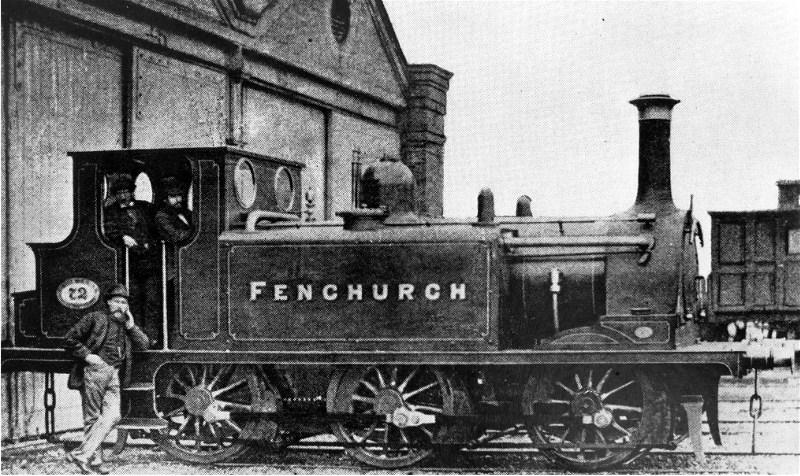
PHOTOGRAPHER UNKNOWN
BRIGHTON LOCO SHED WHICH LATER BECOME THE PULLMAN SHOPS
THE FORMATION OF
THE BRIGHTON BRANCH
Est. 25th August1891
Around the country Enginemen and Firemen at numerous locations on the various Railway Companies deciding to form their own Branches of A.S.L.E.& F. The Amalgamated Society of Railway Servants begun to see many of their Enginemen and Firemen members transferring their membership from A.S.R.S. to the newly formed A.S.L.E.& F. Branches. In some locations the entire A.R.S.R. branch would transfer over to A.S.L.E. & F. This was because many Enginemen and Firemen had become very dissatisfied with the ethos of the A.S.R.S. and wanted a trade union to represent the needs of Enginemen and Firemen.
With the growth of A.S.L.E. & F. members growing across the Brighton Railway with some of the Coastal enginemen belonging to the Battersea Branch. Brighton engiineman William Young along with other enginemen and fireman working at Brighton loco depot decided to start their own Branch and play their part in the growth of A.S.L.E.& F. within the railway. In 1891 their aspirations finally came to fruition in August 1891.
It was on the 25th August 1891 at the Old Star Mission room in Brighton, with a fledgling of 24 members both Enginemen and Firemen that the A.S.L.E.& F. Brighton branch was formed. The Inaugural meeting was opened by the then A.S.L.E.& F. General Secretary Thomas G. Sunter. The Brighton branch was to become the 82nd branch to be established within A.S.L.E.& F. The then, present Brighton members decided that Engineman Bro. William Baudy Young would become their secretary. Bro. William Young decided that this historical event should be recorded and by publishing this achievement it may encourage other Enginemen and Firemen to follow their lead. It was duly reported in the A.S.L.E.& F. Monthly Journal of September 1891 that the Brighton had been formed.
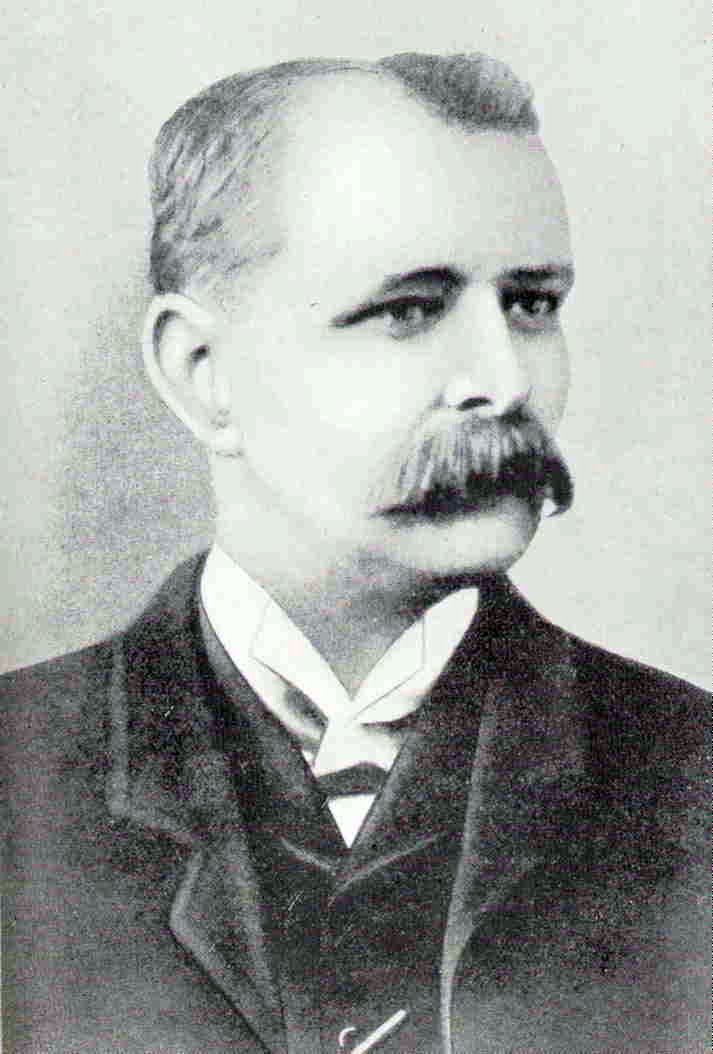
Thomas G. Sunter
A.S.L.E.F. General Secretary 1885 ~ 1901
A.S.L.E.F. COLLECTION
It was quite a common practice for a Branch to be opened at one location and it members
being located at other depots within their area, such was the case with the opening of the
Battersea and Horsham Branch in 1898. Horsham members were based at Littlehampton
and Midhurst (and probably with some members at Three Bridges) depots. This was
indicated in a Horsham Branch report in the Locomotive Journal of October 1911 page
491,.
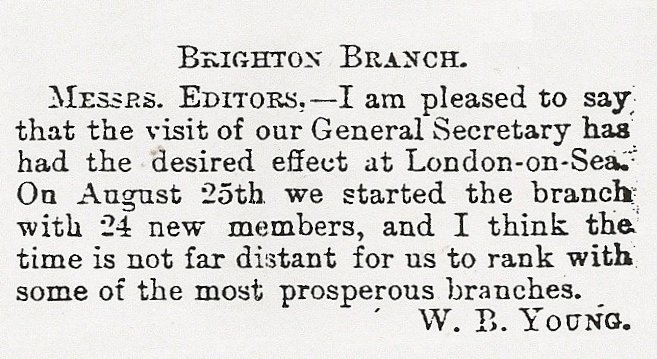
With more Enginemen and Firemen coming forwarded this gave Bro. W. Young the incentive to write another letter to the Locomotive Journal in October 1891 publicising this fact and seeking more journals to encourage more new members to come forward to swell the ranks.
LOCOMOTIVE JOURNAL
OCTOBER 1891
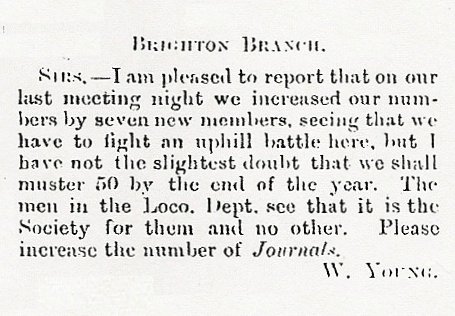
Towards the end of the nineteenth century Footplate men where apprehensive in joining a trade union in fear of loosing their jobs as the Private Companies did not want any form of organised labour. Those who did join wore their trade union fobs (badges) on their watch chain or under their jacket lapels (pictured below). The fobs where to indicate their membership to fellow members and also allowed their entry into A.S.L.E.F. meetings.
When William Young first published an article in the Locomotive Journal about Brighton he made reference to London-by-Sea and did not mentioned Brighton by name. This was because London-by-Sea was a common nick-name given to Brighton at this time. It also helped to hide its identity to the Management of the London Brightonand South Coast Railway. It must remembered that it was not good for the healthy career of a footplateman, in those days, to proclaim his connection to trade union, and so it is no surprise to see briefest of branch reports, with 'Secretary,' 'Chairman,' or some other obscure encrypted nick-name discreetly appended instead of names. This was practise would continue until after the Second World War.
The branch meetings where initially held at the Old Star Mission Room in Brighton on the 4th Tuesday of every month. This location was to be used up until 1896, where a new venue was to be used from 1897. The new venue was the Barber Coffee Room located in London Road, Brighton.The meetings where held on the first Thursday of every month. This venue was to be the branch’s home for many years to come.
By c1911 the meeting were held at The Coffee Room, 2, Cheapside, on the first Sunday in the month, 3 p.m.
Brighton was to become the first A.S.L.E.F. branch within Sussex. This was shortly followed by other locomotive depots, forming their own A.S.L.E.F. branches within the county. Horsham in 1898, Eastbourne, Tunbridge Wells and St Leonards all opening in 1906, Newhaven in 1912, Three Bridges in 1913, Littlehampton in 1917 and Bognor Regis pre 1925.
In 1934 saw two new Branches opening to cater for the newly opened Motorman’s depots at Ore and Seaford Motormen Branches in 1935.
At the moment we have no known records for a A.S.L.E.F. branch at Midhurst. however there is evidence that A.S.L.E.F. members where present at Midhurst locomotive shed.
William Baudy Young
William Baudy Young was born in Epsom in c1854 into a railway family that was residing within the town at that time. William’s father Samuel was recorded in the 1851 census as being a railway labourer and lodging in Deptford and shows him being born in Brightelmstone in c1829.
It is not known whether Samuel Young was employed within the footplate grades at Epsom locomotive department or whether he was still working as railway labourer whilst living in the town.
It was quite common for railway labourers to become engine drivers; this was to meet the rapid expansion of the railway lines across the country and the need for more footplate staff. In the 1871 census shows Samuel was now registered living back in Brighton with his family and employed as an engine driver at Brighton. According to the L.B.S.C.R. archives of 1877, Samuel had transferred to Newhaven (Harbour) locomotive department. It is not known if this was a promotional move from fireman to driver or just a transfer from one depot to another.
The 1871 census also shows his sons William Young was a fireman at Brighton along with his elder brother Samuel (Jnr). The L.B.S.C.R. archives of 1877 show both of them as fireman at Brighton locomotive department.
In 1881, William Young was recorded as a driver and was allocated to work on a “ A” class terrier tank engine No. 41 Piccadilly.
In the early 1900s William was in the 'TOP LINK' and was one of the senior engine drivers at the shed. Other drivers in this included drivers Tompsett, Ellis and Stevens.
Later he was to become a Locomotive Inspector at Brighton, this position was sometime was prior to 1912 (maybe about c1906, after William Young stood down as Brighton A.S.L.E.F. Branch Secretary).
Some of the pioneering A.S.L.E.&F. members of
the Brighton Branch
W. Young, footplate seniority c1871, joined A.S.L.E.&F. c1891
W. G. Lewery, joined A.S.L.E.&F. 1904
A. Barber, joined A.S.L.E.&F. 1905
P. Goatcher, footplate seniority 00.11.99, joined A.S.L.E.&F. 1906
H. Beall, footplate seniority 12.07.97, joined A.S.L.E.&F. 1907
G. Dance, footplate seniority 20.07.03, joined A.S.L.E.&F. 1907
F. Brooker, footplate seniority 22.07.01, joined A.S.L.E.&F. 1907
J. Bignall, footplate seniority 19.02.03, joined A.S.L.E.&F. 1908
W. Coughtry, footplate seniority 04.07.93, joined A.S.L.E.&F. 1909
A. Rogers, footplate seniority 24.01.00, joined A.S.L.E.&F. 1909
W.S. Brooks, footplate seniority 23.04.94, joined A.S.L.E.&F. 1910
BATTERSEA & LONGHEDGE RENAMED TO
BATTERSEA c1891
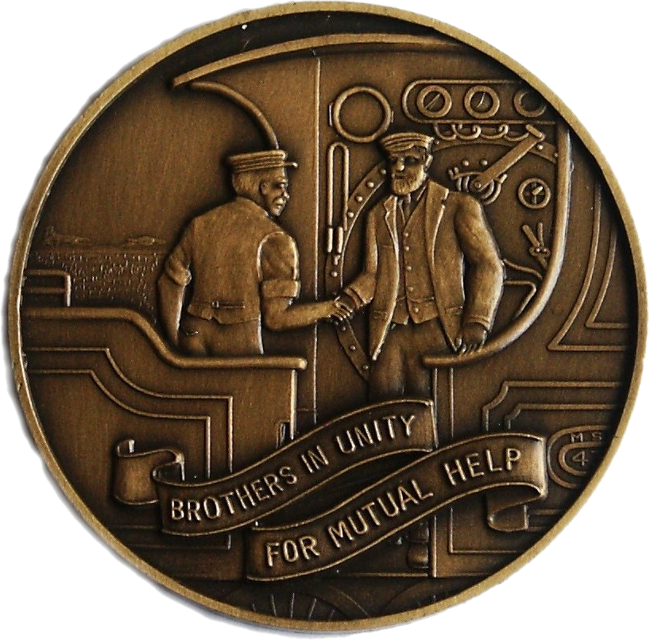
4TH SEPTEMBER 1881
Railway accidents on the
L.B.S.C.R.